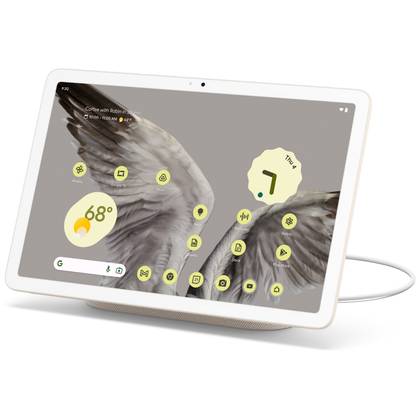In the crowded tablet market, Google sought to carve out a unique niche with its own hardware. Google introduced the Pixel Tablet as a completely different proposition.
It was designed to be a capable Android tablet when in your hands and a smart home hub when snapped to its Charging Dock.
By many accounts, Google partially succeeded. The clean Pixel experience is a joy to use on the big screen.
However, the conventional narrative quickly identified a list of compromises that ultimately stopped the Pixel Tablet.
Key compromises held back the Pixel Tablet
One of the main issues was the 60Hz display. This is an odd choice given that the same Tensor G2 chip powers phones like the Google Pixel 7 Pro, which features an adaptive refresh rate of up to 120Hz.
While overall performance was adequate, it often felt subpar compared to rivals. The lack of first-party productivity accessories, such as an official keyboard or stylus, didn’t help its case.
Adding to this, the USB-C port hides a key limitation that prevents the tablet from realizing its full potential within Google’s own Android ecosystem. This overlooked hardware shortcoming may now be the Pixel Tablet’s biggest weakness.
The tablet’s USB-C port hides a major limitation
The USB-C port symbolizes universal connectivity. One cable, one connector for everything. However, this simplicity is misleading, as USB-C ports and cables can vary.
In this case, the Pixel Tablet’s USB Type-C port supports data transfer and device charging. The port, however, does not support DisplayPort Alt-mode over USB-C for video output.
This mode repurposes high-speed data lanes in the cable to transmit a native DisplayPort signal to an external screen.
For consumers, this means you can’t connect the Pixel Tablet directly to dumb monitors using a USB-C-to-HDMI or USB-C-to-DisplayPort cable. You’d need to buy and use a wireless casting adapter instead.
It’s hard not to notice that this limitation conveniently nudges users toward Google’s own Chromecast ecosystem.
Whether intentional or not, it tries to make sure customers stay within Google’s hardware loop.
Android’s Desktop Mode meets a hardware dead end
Now that Android 16 is coming, this missing feature really stands out. Previously, Android’s multitasking on large screens was limited to a simple split-screen view.
Android 16 introduces a desktop mode. Developer previews reveal a new environment with an app taskbar, freely resizable and movable app windows, and a multi-window environment, similar to Windows or macOS.
It’s the culmination of years of development, finally bringing a Samsung DeX-like experience to the core of Android for all manufacturers to adopt. It is, without a doubt, a notable evolution for Android on large screens.
But there’s a catch. To power this new desktop experience on an external screen, there is one non-negotiable hardware requirement.
Google’s developer documentation states that the device must be capable of connecting to an external display via a DisplayPort connection.
This means Google’s flagship tablet cannot support a key upcoming feature in its own operating system. This hardware choice limits the tablet’s potential.
With video output, the Pixel Tablet could connect to a monitor, keyboard, and mouse, creating a lightweight workstation in a desktop environment.
A future successor must address the original’s core issues
The biggest lesson from the Pixel Tablet saga comes from its canceled second generation.
In late 2024, reports confirmed that the Pixel Tablet 2 had been shelved, a clear signal that the first model’s confused identity hurt its chances in the market.
Leaks from before the cancellation, however, revealed that Google had plans to address the original’s shortcomings, including first-party accessories. Those hints show that Google recognized the design flaws and intended to fix them.
There are still rumors suggesting a third-gen successor could arrive around 2027, but I won’t believe it until I see it. Even if it does, those who invested in the original vision will find the fix long overdue.
For the next generation to succeed, a premium, high-performance tablet experience is essential.
Fans would naturally expect a responsive processor, ample RAM, and a high-resolution, high-refresh-rate display that can compete with the best Android and iPad alternatives.
The tablet should include robust first-party accessories, such as a detachable keyboard and stylus, that integrate seamlessly and justify their cost. Battery life must support heavy use without requiring constant docked charging.
Samsung has already perfected what Google is still developing
If your priority is a versatile tablet that can double as a work machine rather than a smart hub, the Samsung Galaxy Tab series is the clear alternative.
Google is still working on the blueprint, but Samsung has already built the house.
Years of investment in the DeX platform have given Samsung a mature software solution that transforms its tablets into a true desktop-like experience.
It’s so effective that Google partnered with Samsung to integrate its own Desktop mode.
If you want peak performance and don’t mind splurging, the Galaxy Tab S11 is the flagship you can’t go wrong with.
If you’d rather save some money while still getting strong performance and value, the older-gen S9 often goes on sale and is more than capable for any work setup.
Your comment has not been saved
- Brand
-
Google
- Storage
-
128GB or 256GB
- CPU
-
Google Tensor G2
- Memory
-
8GB LPDDR5 RAM
- Operating System
-
Android 14
- Battery
-
7,020mAh
Looking for a smart home hub that can double as a gaming tablet? Google’s Pixel Tablet fits the bill. It flaunts a 10.9-inch IPS LCD screen, backed by the power of the Google Tensor G2 chipset and 8GB RAM for a snappy experience. Its camera setup includes an 8 MP rear and front camera, perfect for capturing those spontaneous moments or crystal-clear video calls.


